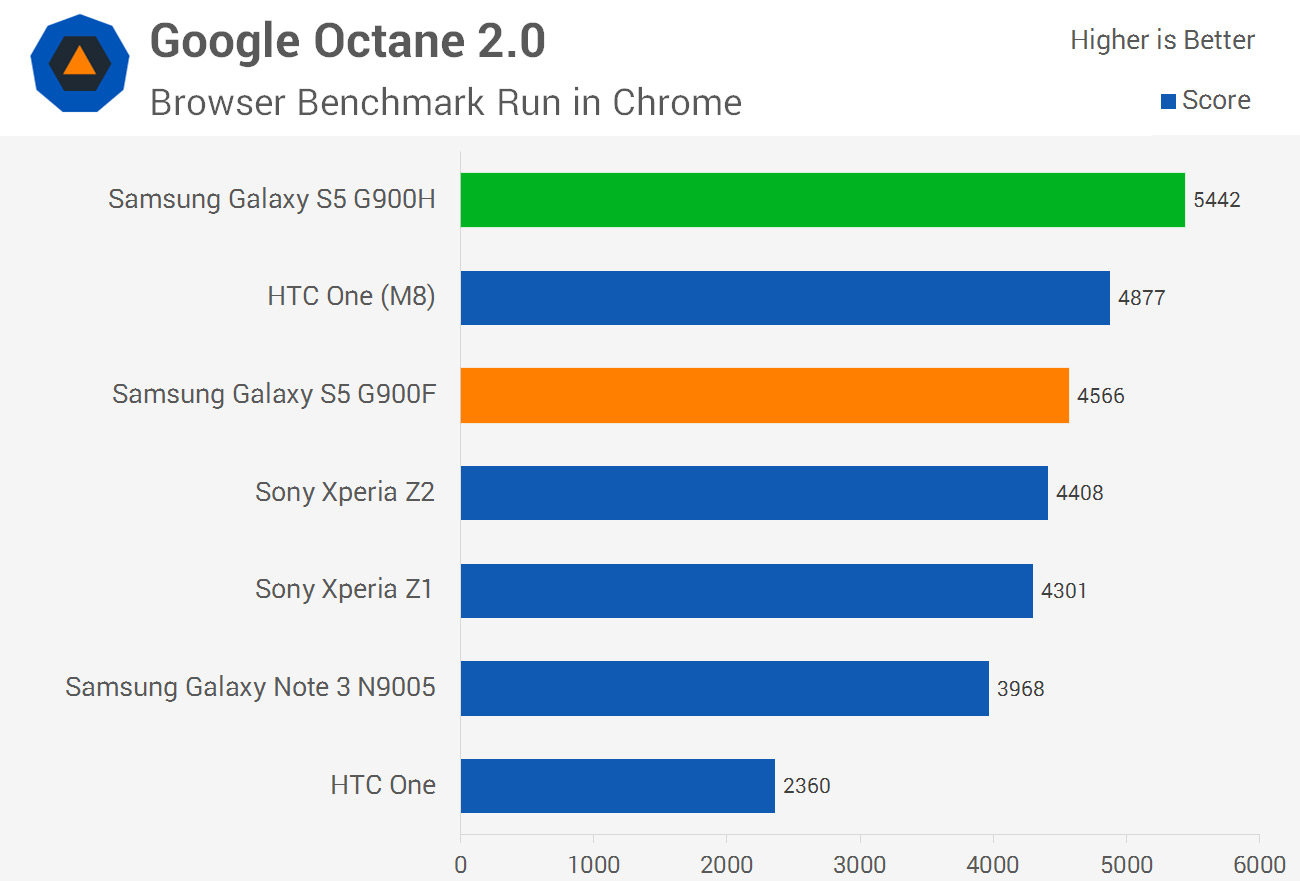Exynos 5 Octa 5422 Performance
We'll start by looking at the web browsing performance of Exynos and Snapdragon Galaxy S5 variants by running our usual benchmarks in the latest version of Chrome for Android. Both handsets come with a stock Android browser, but performance from Chrome is typically better.



On average, the Exynos model outperformed the Snapdragon by a margin of 9%. This is surprising considering the dominance of Qualcomm over the past few years, and can likely be attributed to fully functional HMP, especially as it outperforms the Galaxy Note 3 N900 as well despite packing a very similar SoC.

In Vellamo's single-threaded benchmark we see the Snapdragon 801 equipped Galaxy S5 outperform the Exynos 5 Octa version by 6%. This is a pretty small difference considering how the Krait 400 CPU cores in the Snapdragon 801 are clocked 0.6 GHz higher, with both cores having roughly equal theoretical performance per MHz.

In the new multi-core benchmark we see the G900H stream ahead by 8%, likely as a product of HMP and the fact it has more cores to utilize. This particular benchmark is designed to measure the "synergy of multiple CPU cores", so you won't necessarily get a larger score from having more cores at hand, which is why we don't see a larger advantage to the octa-core model.
In graphics benchmarks we see the Adreno 330 GPU in the Snapdragon model outperform the Mali T628MP6 in Exynos. Going on reported raw performance numbers, which admittedly I haven't been able to verify due to both ARM and Qualcomm keeping fairly quiet on the output of their GPUs, the Adreno 330 should be roughly 60% faster in certain conditions.
This assumes the GPUs are running at their maximum clock speed and aren't thermally constrained, which doesn't always happen, plus CPU power and memory bandwidth can affect the equation as well.

In 3DMark the G900F has a pretty significant performance advantage of 44% over the G900H, and you can also see the similarity in scores between the Exynos Galaxy Note 3 and Exynos Galaxy S5. Looking at the performance breakdown on both devices, the Snapdragon model was able to render the benchmark at around 20 frames per second more, although both achieved very playable frame rates.

Interestingly, in GFXBench's T-Rex HD benchmark the G900H and G900F achieve the same result, indicating a potential memory bottleneck. A memory-limited test isn't too surprising considering this a mobile device, where bandwidth is one of the current weak points.

The new Manhattan benchmark revealed odd results: despite the offscreen test rendering at the same resolution as the onscreen test (1080p), the G900H performed significantly worse onscreen. Comparing offscreen results gives the Snapdragon 801 a 35% performance advantage.
Something I don't normally bother publishing in my reviews is the results from GFXBench's low-level performance tests, usually because these are only useful in directly comparing SoCs as opposed to measuring 'real-world' gaming performance. Luckily this article is about comparing SoCs, so I'll give a short breakdown of the two devices and how they performed.
| Benchmark (Offscreen) | Galaxy S5 G900F | Galaxy S5 G900H | Difference |
| ALU (Shader) | 8930 | 2838 | -68% |
| Alpha Blending | 7611 | 2890 | -62% |
| Driver Overhead | 1608 | 2032 | +26% |
| Texture Fill | 3976 | 2133 | -46% |
| Benchmark (Onscreen) | Galaxy S5 G900F | Galaxy S5 G900H | Difference |
| ALU (Shader) | 1796 | 1413 | -21% |
| Alpha Blending | 7257 | 3323 | -54% |
| Driver Overhead | 823 | 1055 | +28% |
| Texture Fill | 4181 | 2113 | -49% |
The biggest advantage to the Snapdragon 801's Adreno 330 occurs in offscreen raw shader performance, but it sees wins in every category except for driver overhead. It's clear that the G900H and the Samsung Exynos 5 Octa 5422 are dominated in terms of graphics.
Despite the performance edge of Qualcomm, there aren't a huge number of games available on Android that require the extra power of the Adreno 330. Grand Theft Auto: San Andreas was one such game where I noticed the Exynos Galaxy S5 performed worse, but in several other high-end tiles - such as Real Racing 3 and Modern Combat 4 - it was hard to notice a difference.
The NAND benchmark is one I found most interesting from this round of SoC performance testing. Normally this is an area where I'd expect both devices to perform identically, because I'd expect the same NAND chips to be used in both handsets (especially considering both are 16 GB models). However, the results don't match up at all to this hypothesis


The Snapdragon-powered Galaxy S5 has a sizable NAND performance advantage across the board, beating the Exynos model by an average margin of 39%. This indicates the Snapdragon 801 is able to provide a greater amount of NAND interface bandwidth to the chip, or alternatively Samsung is using different storage hardware for both units.
Considering both chips support eMMC 5.0 I'd be leaning towards different NAND hardware.

When I reviewed the Galaxy S5 at launch, I couldn't get USB 3.0 connectivity to function correctly. However a recent software update appears to have addressed this issue. I retested the Snapdragon-powered Galaxy S5 in USB 3.0 mode, alongside testing for the Exynos model, and found both devices give identical USB performance.
The Galaxy S5 is particular quick when it comes to reading over USB 3.0, recording over 110 MB/s copying a 2 GB file to my PC's solid state drive.
